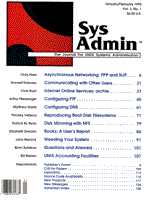
Sidebar: A Sample ftp Session with the -d Option
By default the ftp command on both SVR4 and SunOS systems is in the verbose mode, which means that the server's replies are shown. Setting the -d option causes all of the data to be available on the screen. The following shows such an ftp session:
1: $ ftp -d 2: ftp> open localhost 3: Connected to localhost. 4: 220 drama FTP server (UNIX(r) System V Release 4.0) ready. 5: Name (localhost:dianne): 6: ---> USER dianne 7: 331 Password required for dianne. 8: Password: 9: ---> PASS abc123 10: 230 User dianne logged in. 11: ftp> ls 12: ---> PORT 127,0,0,1,4,26 13: 200 PORT command successful. 14: ---> NLST 15: 150 ASCII data connection for /bin/ls (127.0.0.1,1024) (0 bytes). 16: file1 17: file2 18: 226 ASCII Transfer complete. 19: 14 bytes received in 0.02 seconds (0.68 Kbytes/s) 20: ftp> quit 21: ---> QUIT 22: 221 Goodbye. 23: $
Line 1 is the user request to start an ftp session with the -d, debug, option. Line 2 is the user command to start a connection to the ftp port on the host localhost. Line 3 is ftp informing the user the connection is made. Line 4 is an echo of the reply code coming from the server. The 220 command tells the client machine to send the next command. Line 5 is ftp requesting the account name to use in the ftp session. The material in parenthesis is the default if an enter key is pressed. Line 6 shows the USER command sent to the server. Line 7, the 331 reply, is the reply to line 6. The first 3 of the code is a Positive Intermediate response. The second 3 shows that the response concerns authentication. Looking up the 1 code in RFC 959 shows the account name is okay and that a password is required. The text accompanying the reply code indicates this. Line 8 is ftp asking the user for the password. Line 9 shows that the password is sent across the network in clear text. Since ftp is designed to be operating system-independent, the easiest thing to do is to send the password to the server and let it do the authentication. Line 10 is the reply to the PASS command of line 9. Line 11 is an ls command issued by the user. If the ftp program does not want the data coming back on its control port, it issues a PORT command, line 12. Line 13, reply code 200, shows the server was able to set up a new port for sending data. If the port cannot be set up in 60 seconds, the server times out the connection and returns a reply code 425, "Can't open data connection," to the client. This reply code implies that the command can be re-issued exactly as it was given. The 150 reply code of line 15 means that the data is ready to be transferred on the data connection. The ASCII string shows the command used to obtain the data from the file system. Lines 16 and 17 show the data being transferred. The 226 reply code of line 18 shows all data is transferred and the data connection is closed. Line 19 is from the client ftp program showing how much data was received from the server. Line 20 is the user issuing a quit command to the ftp program. Line 21 shows the QUIT command being transferred to the server. Line 22 is the reply code 221 showing the server is closing the control connection.
|